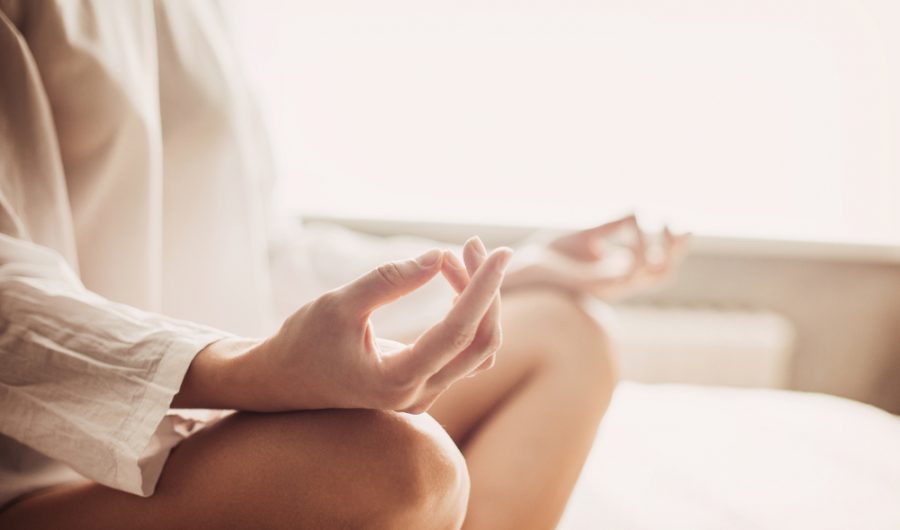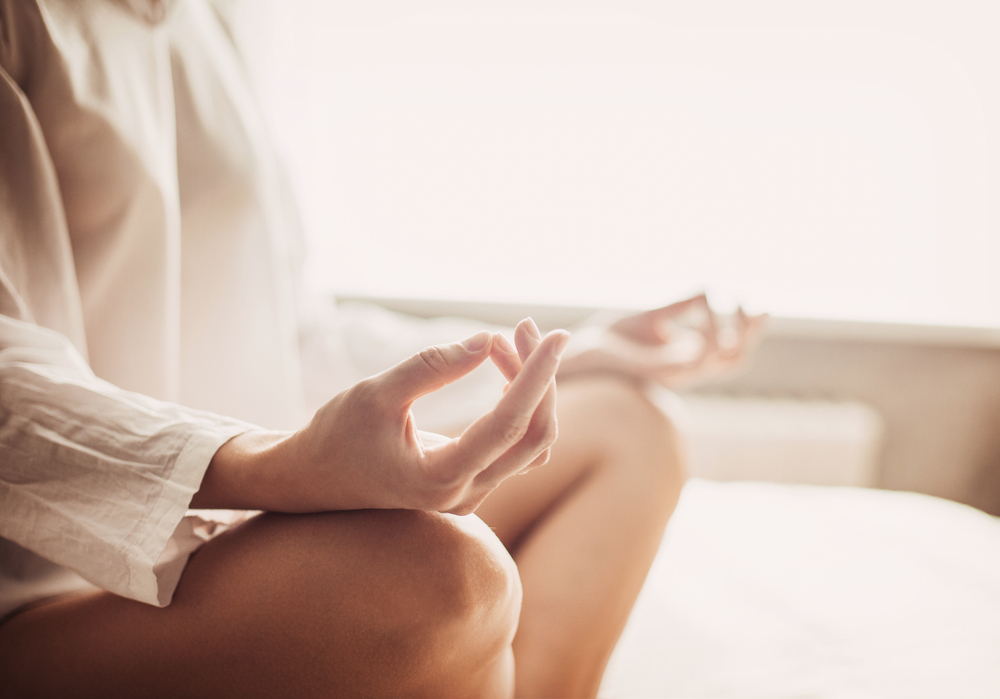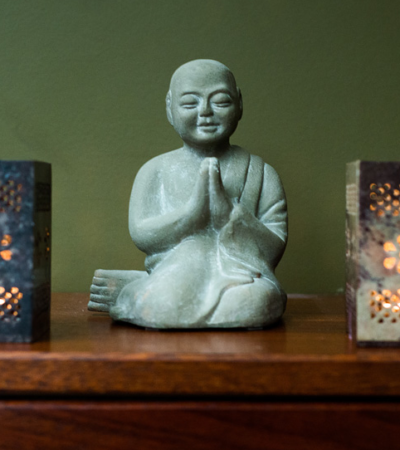words by Kathleen Fleming
I have always loved it when yoga teachers use Sanskrit words. It has a beautiful, soothing sound and using the Sanskrit automatically gives the teacher a certain aura. However, before doing my yoga teacher training, although I loved the sound of many of the yogic terms I didn’t have any idea what they meant. I never wanted to disturb the beautiful peace after each class with endless questions or be that person who traps the teacher in a deep post-class conversation.
Yoga classes can be confusing especially if the teacher doesn’t clearly explain things or doesn’t use the English and Sanskrit terms. To help yoga students, I have put together a quick guide to some common yoga terminology.
Anjali Mudra (pronounced AHN-jah-lee MOO-dra) is the bringing together of the hands at the heart centre. It literally means a salutation seal and is often done at the end of the class or in certain poses such as tree pose. Teachers will say “place your hands in prayer” rather than use the words “anjali mudra”. Symbolically the joining of the hands at the heart centre yokes the left and right hemispheres of the brain, honouring the self and the other/all things.
Asana (pronounced Ah-Suh-Na) literally means “seat” or “pose”. It is also interpreted as the physical practice of yoga. For example you may hear the words “your daily asana practice” which means your daily physical yoga practice. Asana, as the physical practice is only one element of traditional yoga practice. Furthermore, most physical poses have Sanskrit names which end in the word “asana”, such as “virasana” meaning “hero pose”.
Chaturanga (pronounced chaht-tour-ANG-ah) is an abbreviation of the pose name “chaturanga dandasana” which means “four limbed staff pose” in English. Most teachers will say “move into chaturanga” instead of using the full pose name. It is also one of the poses where teachers will use the Sanskrit rather than the English. In “chaturanga” you lower yourself down towards the ground with your body in a straight line. The pose is also one part of the sun salutation sequence, linking downward facing dog to upward facing dog. You need to be strong and a fairly advanced practitioner to do this pose properly. A good teacher will provide an easier alternative if you are not ready for it.
Namaste is said at the end of a lot of yoga classes, as well as occasionally at the beginning of a class. It is a Sanskrit greeting and literally means ” I bow to you” or “the divine light in me bows to the divine light in you.” Although the word is often spoken, the action of bringing the palms together at the heart and bowing the head also means “namaste”. After most classes, the teacher says “namaste” first as a symbol of gratitude and respect towards his/her students and his/her own teachers. Students normally respond with the same as an expression of their gratitude.
Om or Aum does not have a literal English translation but it carries a lot of meaning. The ancient yogis believed the sound to be the primordial sound of all creation, the sound from which all other sound arises. Originally it is made up of three sounds 1) AHHH 2) OOOO 3) M (pronounced with the tongue at the roof of the mouth so it sounds like a bee buzzing) which was spelt out as “AUM”. The three sounds symbolise our waking state, our dreaming state and our sleeping state. The three sounds are then followed by silence which symbolises the state of perfect bliss. A teacher may begin or end a class with one, two or three “oms” in order to create a sense of harmony and unity among the students. The sound created also has an energising yet relaxing effect.
Pranayama is another important element of traditional yoga practice and it literally means “control of breath”. The Sanskrit word is made up of two words – “prana” which means life-giving force and “ayama” meaning control. Our breath is our most important form of “prana” together with water and food. Many of us do not breathe properly, taking shallow breaths and only using a small proportion of our lung capacity. In most asana classes teachers will incorporate pranayama exercises. Regular pranayama practice helps to reduce stress, anxiety and insomnia as well as having an energising effect on the body.
Savasana (pronounced shah-VAHS-anna) is the pose done at the end of most yoga classes. It is literally translated as “corpse pose” and involves lying on your back with your arms and legs outstretched. To the ancient yogis it was a symbol of re-birth, leaving behind all that went before and starting afresh. It is the most important pose of any class as it allows your body to integrate and assimilate all the information it has learnt from the class. In addition, it allows you to be completely still and quiet in body and mind – something we all struggle with in this crazy world.
Ujjayi Breath (pronounced ooh-JAI-yee). “Engage your Ujjayi Breath,” says the teacher and then everyone starts making heavy breathing noises. The first time I heard this I was completely overwhelmed. “Ujayi Breath” is translated as “victorious breath”and it is often described as “ocean breath” because it sounds a bit like waves rolling in and out. Ujjayi breathing has an energising and relaxing effect on the body and mind. To practice Ujjayi breath, gently inhale and as you exhale slowly and gently, slightly constrict the opening of the throat to create some resistance to the air. The breath should be smooth and not rasping or grating.
Vinyasa. “Take a vinyasa”, says the teacher. Normally used in flow classes, a “vinyasa” is a series of movements linked by the breath. As well as a popular style of yoga (Vinyasa Flow), the word most commonly refers to the movement of the sun salutation but can be used to refer to any particular series of movements linked to the breath.
Armed with your new Sanskrit vocabulary, in your next yoga class you will be “omming” with confidence and taking a “vinyasa” without waiting to see what everyone else does first. Namaste.














